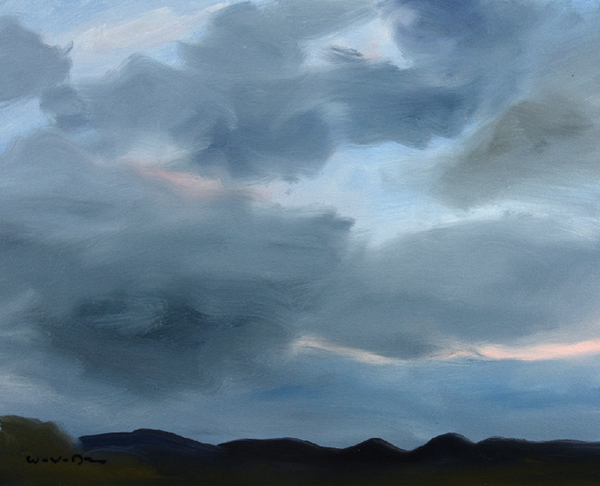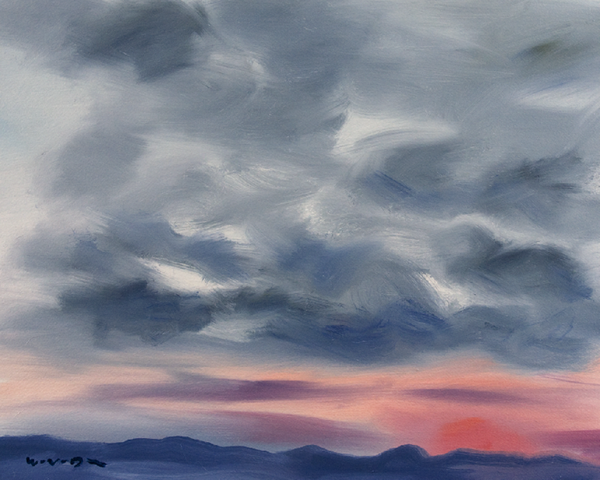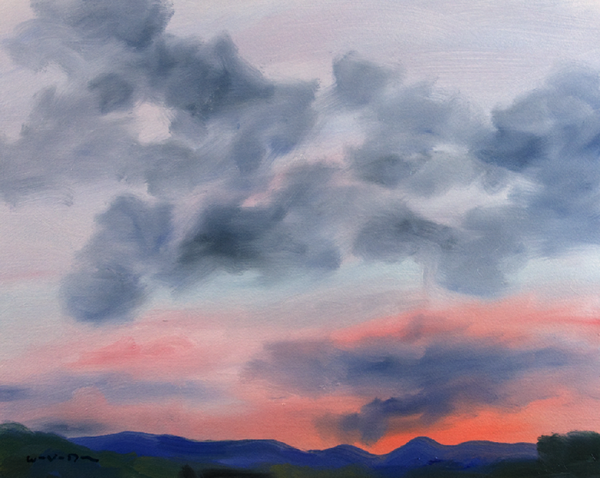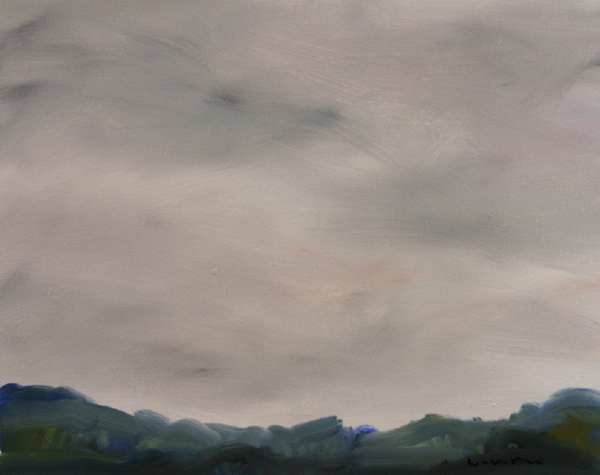 Friday, July 10, 2009 at 09:30PM | by
Friday, July 10, 2009 at 09:30PM | by  BVD | in
BVD | in  Sunset Paintings | tagged
Sunset Paintings | tagged  Albemarle County,
Albemarle County,  Lakshmi Danis,
Lakshmi Danis,  Mohan Danis,
Mohan Danis,  Stony Point,
Stony Point,  Willa Lin,
Willa Lin,  teaching art | | Comments Off
teaching art | | Comments Off  Friday, July 10, 2009 at 09:30PM | by
Friday, July 10, 2009 at 09:30PM | by  BVD | in
BVD | in  Sunset Paintings | tagged
Sunset Paintings | tagged  Albemarle County,
Albemarle County,  Lakshmi Danis,
Lakshmi Danis,  Mohan Danis,
Mohan Danis,  Stony Point,
Stony Point,  Willa Lin,
Willa Lin,  teaching art |
teaching art |  Share Article | Comments Off
Share Article | Comments Off  Stony Point, Albemarle County, Va. Oil on paper, 16 x 20.
Stony Point, Albemarle County, Va. Oil on paper, 16 x 20.
Out with Flint today (new visitors: Flint’s a pound-found foxhound, runs 10–15 or more miles while I walk about seven, cross-country) – I didn’t realize what a rare summer day it was until I had to come down off the embankment above the Rivanna to encourage him to go in and get a drink.
There’d been a gunshot in the distance somewhere across the way. He’d just gotten in the water, heard the shot, sort of stood there looking in its direction for a moment, then scrambled up the 20 feet or so to where I was standing. (He’s a gun-, thunder- and, probably safe to assume, whip-shy foxhound, which may be why he came to be at the pound.)
I decided that, after running in the heat, he’d better get some water, and, hoping there wouldn’t be any more shots, I found my way down to one of the sand bars on the river. Flint, feeling a little safer with me (as seen previously here), followed – and started walking around in the water, lapping it up as he went.
The view from river level was a revelation – partly because it’s so familiar. I’m so used to everything being kind of hazy at this time of year – the woods up and down the river arching from the banks and bluffs toward the water, the many sand bars and mud flats and the stranded trees stuck in various places by floods, but all of this more or less bonded by a subtle metallic veil of humidity. In typical light, even the river itself fails to separate, the view upstream or down, foreshortened at a low angle, opaque reflection – light bouncing into other light bounced everywhere by atmosphere.
It’s an effect I’ve loved since I was a kid and that I would deliberately exaggerate, blurring my eyes to make everything even more unified.
(“Please don’t throw me in that briar patch!”)
As much as I can revel in the murk, I was stunned by the Rivanna in the clear light of such a blue summer day. The shallow river was crystal clear, showing sand and silt-rock-leaf bottom like a brownish topaz. Every variation on the bottom, every bubble and wrinkle in the current showed itself. Trees all along the banks stood out in infinitely varied green relief and distinct perspective, not the usual moody mass. So vivid and fresh, the clarity of what I was seeing became part of the touch of the air, and the sensation of breathing.
Curiously, the sharp distinctions took nothing away from the ‘oneness’; if anything, they made it almost too much.
Watching the beautiful white dog walk in the water and drink it at the same time didn’t hurt, either.
The coolest moment came about an hour later when we made our second pass by the river – turned out Flint was somewhere in back of me on a ramble, or a chase, but I came to the edge of the embankment just in case I might find him down there. No dog, but through the foliage on the surface of the water the shadow of a large bird moving swiftly up the middle of the river. I looked up, wondering if I’d be able to make out what was casting the shadow. Through the leaves above my head, maybe 30 feet above the river’s surface, I caught a long look at a great blue heron flying through the light.
 Wednesday, July 8, 2009 at 09:22PM | by
Wednesday, July 8, 2009 at 09:22PM | by  BVD | in
BVD | in  Sunset Paintings | tagged
Sunset Paintings | tagged  Albemarle County,
Albemarle County,  Blue Ridge,
Blue Ridge,  Rivanna River,
Rivanna River,  Stony Point |
Stony Point |  Share Article | Comments Off
Share Article | Comments Off  Stony Point, Albemarle County, Va. Oil on canvas, 16 x 20.
Stony Point, Albemarle County, Va. Oil on canvas, 16 x 20.
On an alien planet with a double sunset, one of the suns fell orange on a purple-magenta horizon and soon another showed up, blazing rose against the orange sky left over from the first. A bit confusing for a painter from Earth. The atmosphere seemed quite breathable, the vegetation familiar. I recognized everybody in the house. Just don’t know how we got here.
 Tuesday, July 7, 2009 at 09:23PM | by
Tuesday, July 7, 2009 at 09:23PM | by  BVD | in
BVD | in  Sunset Paintings | tagged
Sunset Paintings | tagged  Albemarle County,
Albemarle County,  Blue Ridge,
Blue Ridge,  Stony Point |
Stony Point |  Share Article | Comments Off
Share Article | Comments Off  Stony Point, Albemarle County, Va. Oil on paper, 16 x 20.
Stony Point, Albemarle County, Va. Oil on paper, 16 x 20.
“What a difference a day makes.”
This line, which came to me of course because of the change from yesterday, made me think of my dad, because he used to sing the song all the time. More precisely, he’d always sing the first two lines –
What a difference a day makes
Twenty-four little hours
– and that’s all. This of course left me in some doubt as to whether the difference a day made was good or bad. Little did I know that the difference:
Brought the sun and the flowers
Where there used to be rain.
I might attribute this truncation to some sadness in Dad’s life, of which there was plenty, except many songs went on beyond their initial lines to spell out a sad tale, and he didn’t go on with those, either. For example, of “Blues in the Night” (Harold Arlen and Johnny Mercer), what I always heard was:
My mama done told me
When I was in knee pants
My mama done told me, ‘Son ... ’
Really, it was 40 years before I found out what it was his mama done told him.
All I ever knew of W.C. Handy’s “St. Louis Blues” was:
I hate to see that evening sun go down.
And he sang that line literally hundreds of times, just out of nowhere. I think I even remember my mother singing that line, and she hardly sang at all.
(The most wonderful song along these thematic lines – my #1 diurnal tune – is “Rising Sun” by Sonny Terry and Brownie McGhee.)
The difference a day makes is one facet of painting these sunsets – but I’m thinking that the difference it doesn’t make is at least an equally large and the more subtle part of the matter. What I notice when I see all the days arrayed is both change and the constant – something in time that doesn’t change.
This thought in turn makes me wish I could have paid more attention to both math and physics – and specifically to mathematical constants – evidently numbers that arise naturally, such as pi, the ratio of a circle’s circumference to its diameter (well, yes, I know you knew this, but I’d totally forgotten) – and to physical constants, like gravitation or the speed of light.
I never thought any of that was very interesting, or relevant to what I was interested in. Now I think there’s a Constant embedded in the succession of days.
 Monday, July 6, 2009 at 09:24PM | by
Monday, July 6, 2009 at 09:24PM | by  BVD | in
BVD | in  A Painting A Day,
A Painting A Day,  Sunset Paintings,
Sunset Paintings,  Sunsetology | tagged
Sunsetology | tagged  Albemarle County,
Albemarle County,  Blue Ridge,
Blue Ridge,  Harold Arlen,
Harold Arlen,  Johnny Mercer,
Johnny Mercer,  Stony Point,
Stony Point,  Theodore Van Doren,
Theodore Van Doren,  W.C. Handy,
W.C. Handy,  pi,
pi,  “Blues in the Night”,
“Blues in the Night”,  “St. Louis Blues”,
“St. Louis Blues”,  “What a Difference a Day Makes” |
“What a Difference a Day Makes” |  Share Article | Comments Off
Share Article | Comments Off  Stony Point, Albemarle County, Va. Oil on paper, 16 x 20.
Stony Point, Albemarle County, Va. Oil on paper, 16 x 20.
Longtime readers – i.e., anyone who’s been around since we started in April – will know that we looked out for, and never found, blackberry winter, but did have a spell of huckleberry autumn and then a winter of the wild rose. Today, with the daytime temperature settling at 63°F, we had what we might call Winter at Wimbledon.
Barbecuing would have been good to do, just to warm up.
 Sunday, July 5, 2009 at 09:06PM | by
Sunday, July 5, 2009 at 09:06PM | by  BVD | in
BVD | in  Sunset Paintings | tagged
Sunset Paintings | tagged  Albemarle County,
Albemarle County,  Stony Point,
Stony Point,  blackberry winter |
blackberry winter |  Share Article | Comments Off
Share Article | Comments Off
Looking at the Sunset (Part 6)
What I’ve been working up to in this series of posts on ‘Looking at the Sunset’ is two-fold. The immediate purpose and impulse is just to talk about how my view of the sunset – literally the view, what you can see from here – has changed in the more than 14 years since I started. But I find I can’t really describe that without getting into how this began and where it’s going.
I didn’t much notice or care about sunsets and sunrises until not long before I began this series in 1995. It had never occurred to me to paint one, and I’d been painting for more than 25 years. And this is despite the fact that, in Batesville, Virginia, at a place called Port-a-Ferry Farm, the tiny ‘country villa’ I rented for seven years until 1990 had a truly spectacular western view of the Blue Ridge.
But by mid-1993, I was coming to the end of a relatively dark couple of years – sort of like waking up from a long low-grade nightmare. Part of the waking up was sitting outside and watching the sun go down. This was at a house I rented on a farm just four miles from where I’m living now, in the Stony Point area of Albemarle; the rickety narrow side deck offered a great view of the sunset.
Then I moved to Glendale, off Scuffletown Road in Orange County – another rental, but a 400-acre farm where my nearest neighbors were one mile in any direction. (Have I mentioned being a bit of a recluse?) Believe it or not, this was the view from my front door:
However, that view was to the east, and even though there were some beautiful sunrises, my state of mind early in the morning tended to be more one of just trying to wake up than of reveling in the wonders of the world. To the west, in back of the house, a large wooded hill reared up and blocked out the sunset. To my surprise, I found this kind of irritating – I hadn’t reckoned on not seeing sunsets or on caring whether or not I did. I even went to the trouble a few times of climbing the hill to see what I could see, but couldn’t see much.
After one year, in May 1995, Glendale had been ‘sold out from under me’ – as we powerless renters like to say. I found the place where I’m living now, back again in Stony Point, in Albemarle County. (I met Laura six months later and we’ve been living here since we married in June 1997. Our nearest neighbor is much closer than mine were at Glendale; but then, this is the only house on more than 1,000 acres.)
One of the first things I noticed, just after moving in, was the sunset from the back yard. The sun went down behind wall-to-wall Blue Ridge – big sky, big earth. Soon I started thinking I should just go out and paint the sunset.
Part of the motivation – the part that didn’t come simply from the view itself – was that I was only an occasional painter – or better put, as they say in baseball, a streaky one – and strangely slow and deliberate. I would start out fast, and in those initial hours seem to come very close to something exciting and finished, then settle into months of elaboration – glazings and subtle revisions – which might work out very well, yet the result would not have quite the same energy I’d started with. I was like a general who carries the field right up to the adversary’s HQ, but then stops and digs trenches. Given that situation, the sunset seemed like a way almost to trick myself into painting more often and painting more freely and quickly.
In a sense, I started painting the sunset because, here, I could see it – ‘because it was there.’ I think the part of my impulse that I tend to discount is how my relationship with this fundamental daily fact of life had already affected me. That’s an aspect of the series that I’m still uncovering.
On top of the simple decision to paint sunsets there’s the further question of painting them every single day, which I didn’t start doing til September 1997. When I was painting my first sunsets, in June 1995, a visitor suggested perhaps doing them every day. It sounded crazy – or actually not so much crazy as scary, because of the commitment involved – but I didn’t want to mention that I’d already thought of that. I just didn’t quite have the nerve to start, or maybe I didn’t yet see the sense in it – or sense the sense in it, because the sense is difficult to see outright.
So, back in 1995, the sunset here was pretty plain to see; after all, that’s what prompted me to start. The sweep of the old view is suggested by this very small painting of the sunset of June 21st, 1996, less than 24 hours after the summer solstice:
What’s funny to me is how much the view of the sunset here has changed, how difficult that sometimes makes things – and, in the end, how little it may matter.
I’ve alluded to this change in the view in my posts about the volunteer peach tree and my sketch of the back yard. Since 1995, all sorts of trees and bushes have sprung up along the back: the volunteer peach, a box elder that’s growing a mile a minute, a ‘tree of paradise’ (ailanthus) just behind it that seems to be growing even faster, a volunteer peach tree that isn’t a peach tree just to the left of the box elder (its fruit are more like nectarines but I’m not sure, and they’re exuberantly exuding clear sap), and a sour cherry (aka pie cherry) just in front and to the left of that. These are in addition to the big red oak in the right corner of the yard, a big white oak in the field behind that, a tall dark cedar in the field in the middle of the view, and a truly enormous venerable white oak to the left of the cedar.
(Sorry to go on in so much detail about the contents of our back yard – but I’ve spared you the really picky little details!)
In any case, that trees grow is hardly surprising. What I never thought about, and wasn’t prepared for, was how “the woods” in aggregate get so much taller in what seems like such a short time.
Here’s a funky little schematic of the current view:
(The “garden in ruins” – a big circular space that normally would have at least 30 heirloom tomato plants plus basil, Italian parsley, beans, okra, Florence fennel, cucumbers, sweet peppers, etc. – is a testament to the time demands of blogging and, perhaps even more, to the psychic diversions of hoping any day to find a place we can buy and call our own.)
The kicker – the sockdolager in all of this (just had to use that weird crazy word, which I’ve only ever seen once, in a manuscript by an old friend, Bill Crandall) – the most important factor in this changing view is the woods. I guess I always just thought the woods were what they were – the woods, mature, pretty much unchanging.
But “the woods” must be jumping up quite a bit every year. Who knew?
Meanwhile, as for the growth of the mountains – not so much. In fact, I hear the Appalachians have been taking it on the chin for something like 60 million years.
The result, visually, is that I can’t see as much of what’s going on, or can’t see as easily, as I could at the beginning, resulting in the little dance I once described, in which I sometimes have to bob and weave to see the sun. I may have to stand on the back porch steps to confirm whether or not the mountains are even visible in clouds or haze, and it may require repairing to various upstairs ‘observatories’ to see clearly just where along the mountains the sun is setting.
Now – I really wonder why I needed to tell you any of this, except by way of a sort of personal diary, which is exactly the sort of blog I knew from the outset I did not want this to be. One reason is to indicate that these paintings are somewhat more stylized than they may appear; my purpose has never been, primarily, to record or transcribe.
But further: I believe that somehow these paintings may have more to do with sunset as an event than with sunset as a picture. I suspect a perfectly legitimate series could be done without seeing the sun set – as long as it corresponded in a meaningful way to the event. In the end, like anything else in any of the arts, work stands simply on how and what it communicates.
Meanwhile, I’ll keep looking through the gap between the peach and the box elder.
A little more orientation. Here’s the house:
The perspective for the sunset paintings is usually from directly in back of the house. Sunrise paintings are done from just about where Laura is standing for this shot, looking in the opposite direction. That’s the morning sun in the window. The big red oaks on either side of the house aren’t even mentioned in my schematic, they’re behind me in that sketch. Plus there are three equally large oaks above us here, not in the photo.
Funny thing is, when the old-timers who used to either live here or see their relatives here drop in to visit the old house – and this has happened four times – they always start out the same way: “What happened to all the big trees?” (!!?)
(A fine poem about one of those visits – you have to click on “The Visit” – can be found here.)
Aerial view:
In summer, looking at the sunset means looking almost toward the upper left corner of this picture – or, from my perspective on the ground, toward my right (toward the north). The amphitheater-like curve of the trees in most of my sunsets comes from the fact that the trees are closest on the left and right of the back field, and that field falls away steeply in the middle.